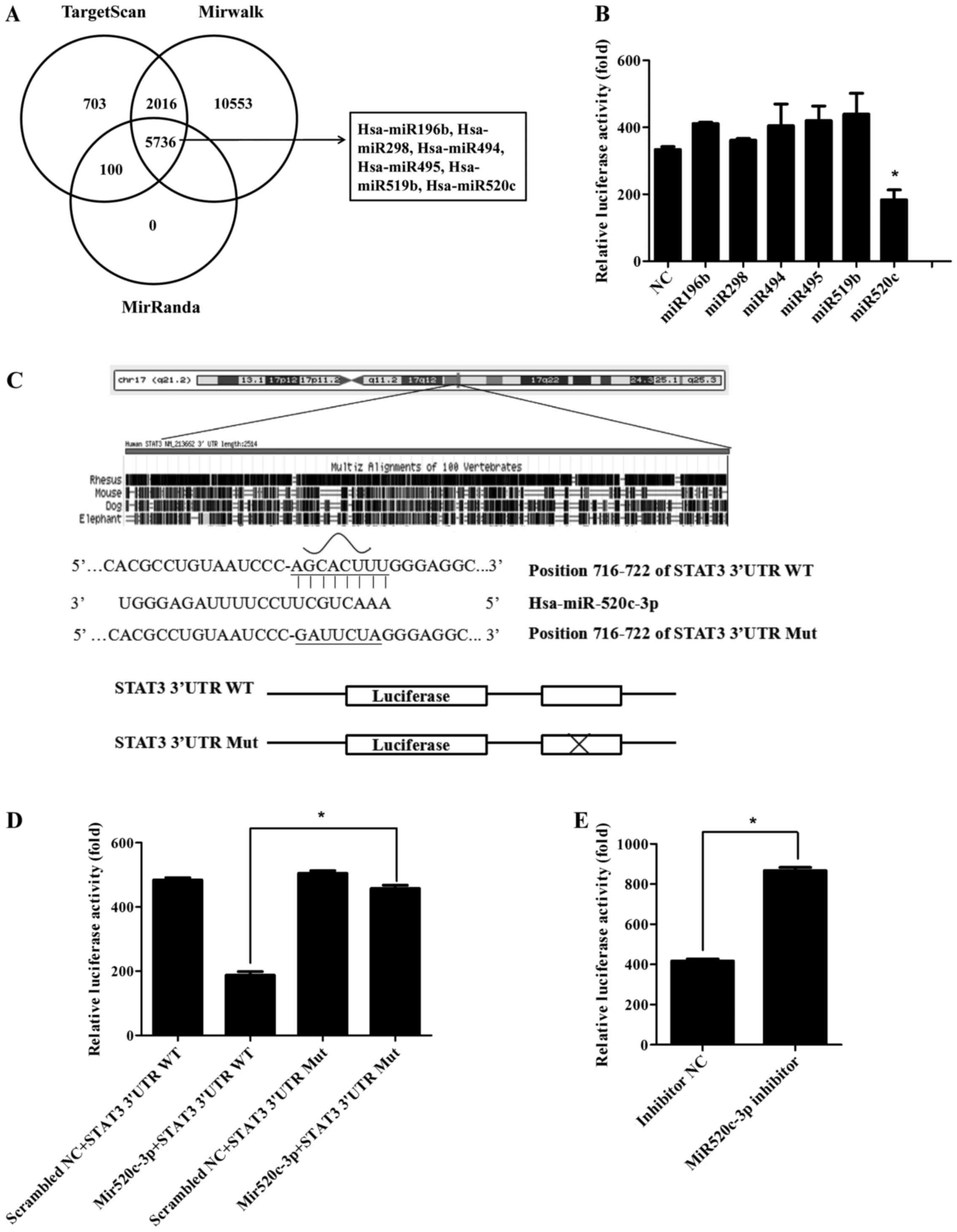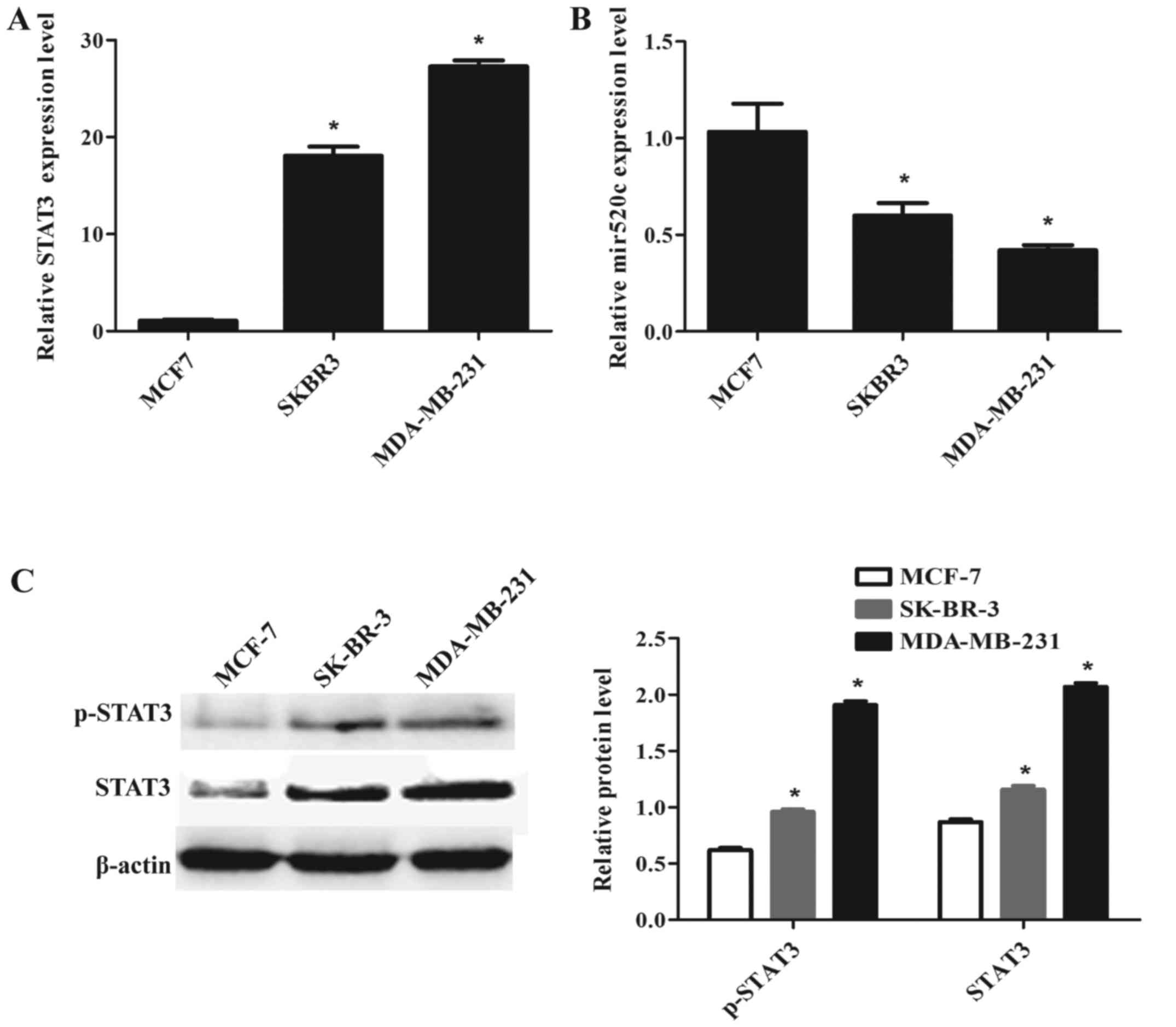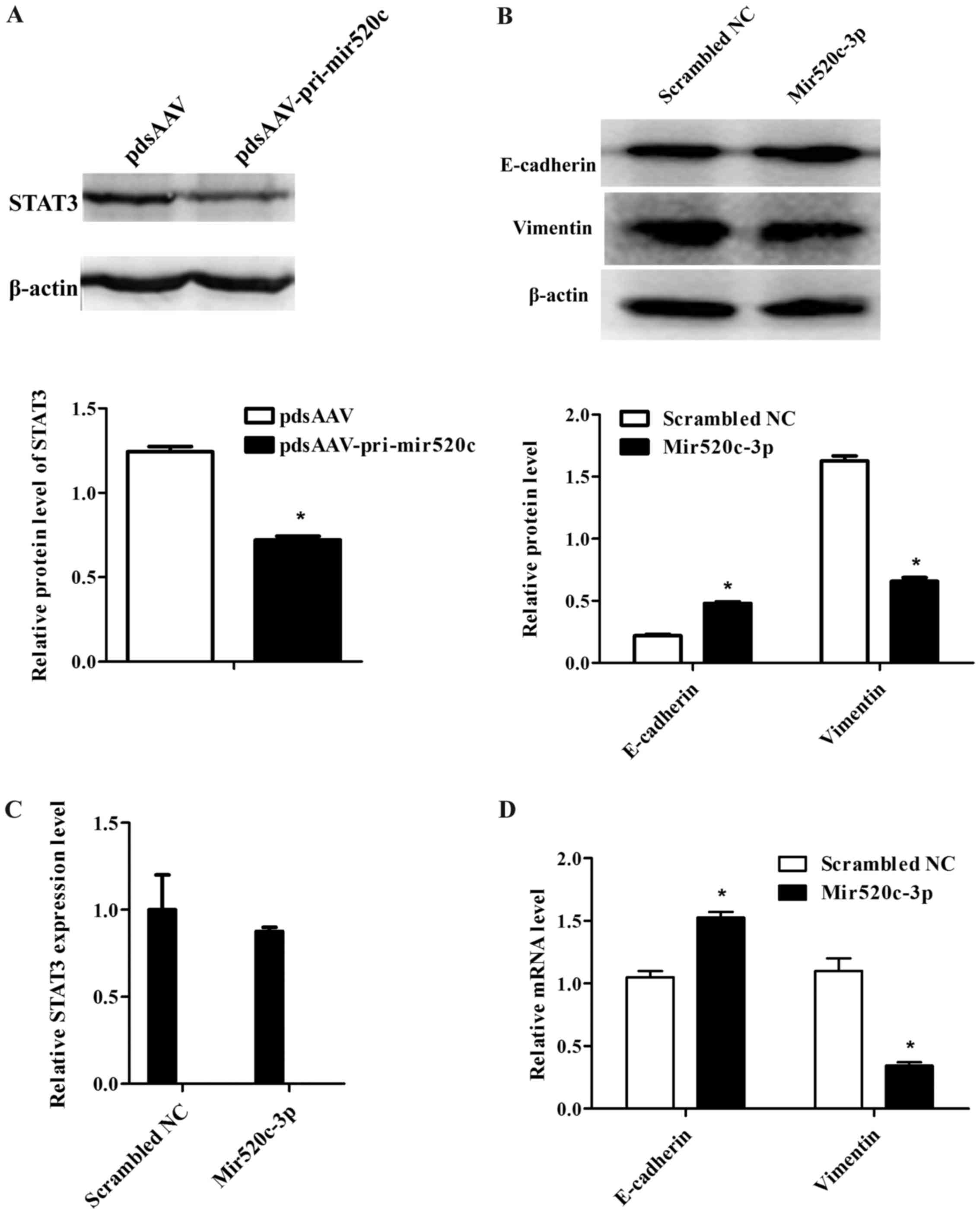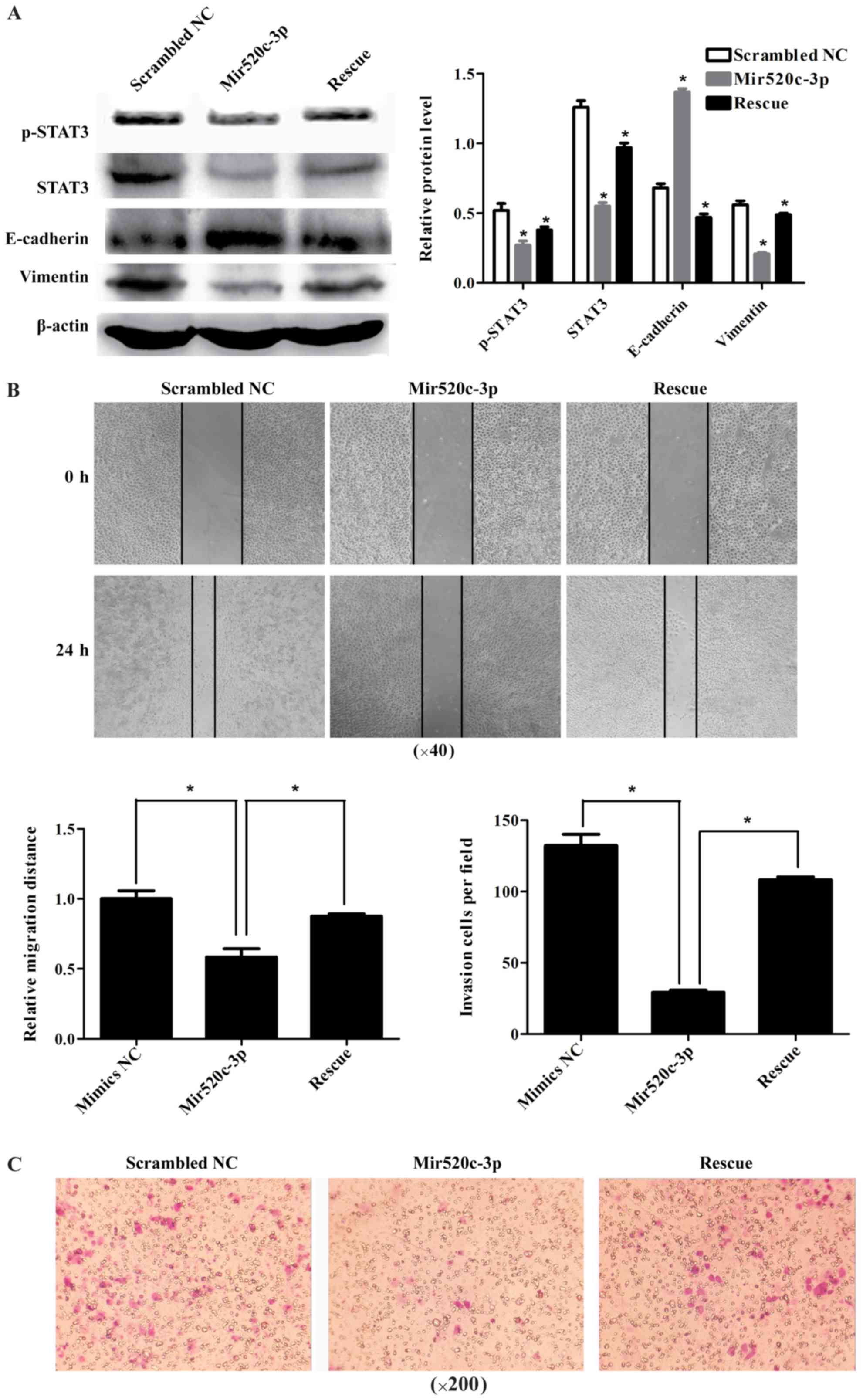|
1
|
De Martel C, Ferlay J, Franceschi S,
Vignat J, Bray F, Forman D and Plummer M: Global burden of cancers
attributable to infections in 2008: A review and synthetic
analysis. Lancet Oncol. 13:607–615. 2012. View Article : Google Scholar : PubMed/NCBI
|
|
2
|
Parker JS, Mullins M, Cheang MC, Leung S,
Voduc D, Vickery T, Davies S, Fauron C, He X, Hu Z, et al:
Supervised risk predictor of breast cancer based on intrinsic
subtypes. J Clin Oncol. 27:1160–1167. 2009. View Article : Google Scholar : PubMed/NCBI
|
|
3
|
Yaacoub K, Pedeux R, Tarte K and
Guillaudeux T: Role of the tumor microenvironment in regulating
apoptosis and cancer progression. Cancer Lett. 378:150–159. 2016.
View Article : Google Scholar : PubMed/NCBI
|
|
4
|
Ma YF, Ren Y, Wu CJ, Zhao XH, Xu H, Wu DZ,
Xu J, Zhang XL and Ji Y: Interleukin (IL)-24 transforms the tumor
microenvironment and induces anticancer immunity in a murine model
of colon cancer. Mol Immunol. 75:11–20. 2016. View Article : Google Scholar : PubMed/NCBI
|
|
5
|
Sweis RF, Spranger S, Bao R, Paner GP,
Stadler WM, Steinberg GD and Gajewski TF: Molecular drivers of the
non-T cell-inflamed tumor microenvironment in urothelial bladder
cancer. Cancer Immunol Res. 4:563–568. 2016. View Article : Google Scholar : PubMed/NCBI
|
|
6
|
Fernandez-Garcia B, Eiró N, Miranda MA,
Cid S, González LO, Domínguez F and Vizoso FJ: Prognostic
significance of inflammatory factors expression by stroma from
breast carcinomas. Carcinogenesis. 37:768–776. 2016. View Article : Google Scholar : PubMed/NCBI
|
|
7
|
Dieci MV, Griguolo G, Miglietta F and
Guarneri V: The immune system and hormone-receptor positive breast
cancer: Is it really a dead end? Cancer Treat Rev. 46:9–19. 2016.
View Article : Google Scholar : PubMed/NCBI
|
|
8
|
Griesinger AM, Josephson RJ, Donson AM,
Levy JM Mulcahy, Amani V, Birks DK, Hoffman LM, Furtek SL, Reigan
P, Handler MH, et al: Interleukin-6/STAT3 pathway signaling drives
an inflammatory phenotype in group A ependymoma. Cancer Immunol
Res. 3:1165–1174. 2015. View Article : Google Scholar : PubMed/NCBI
|
|
9
|
Bromberg JF, Wrzeszczynska MH, Devgan G,
Zhao Y, Pestell RG, Albanese C and Darnell JE Jr.: Stat3 as an
oncogene. Cell. 98:295–303. 1999. View Article : Google Scholar : PubMed/NCBI
|
|
10
|
Yu H, Pardoll D and Jove R: STATs in
cancer inflammation and immunity: A leading role for STAT3. Nat Rev
Cancer. 9:798–809. 2009. View
Article : Google Scholar : PubMed/NCBI
|
|
11
|
Garcia R and Jove R: Activation of STAT
transcription factors in oncogenic tyrosine kinase signaling. J
Biomed Sci. 5:79–85. 1998. View Article : Google Scholar : PubMed/NCBI
|
|
12
|
Meltzer PS: Cancer genomics: Small RNAs
with big impacts. Nature. 435:745–746. 2005. View Article : Google Scholar : PubMed/NCBI
|
|
13
|
Benhamed M, Herbig U, Ye T, Dejean A and
Bischof O: Senescence is an endogenous trigger for
microRNA-directed transcriptional gene silencing in human cells.
Nat Cell Biol. 14:266–275. 2012. View
Article : Google Scholar : PubMed/NCBI
|
|
14
|
Filipowicz W, Bhattacharyya SN and
Sonenberg N: Mechanisms of post-transcriptional regulation by
microRNAs: Are the answers in sight? Nat Rev Genet. 9:102–114.
2008. View
Article : Google Scholar : PubMed/NCBI
|
|
15
|
Kunej T, Godnic I, Ferdin J, Horvat S,
Dovc P and Calin GA: Epigenetic regulation of microRNAs in cancer:
An integrated review of literature. Mutat Res. 717:77–84. 2011.
View Article : Google Scholar : PubMed/NCBI
|
|
16
|
Calin GA, Sevignani C, Dumitru CD, Hyslop
T, Noch E, Yendamuri S, Shimizu M, Rattan S, Bullrich F, Negrini M,
et al: Human microRNA genes are frequently located at fragile sites
and genomic regions involved in cancers. Proc Natl Acad Sci USA.
101:2999–3004. 2004. View Article : Google Scholar : PubMed/NCBI
|
|
17
|
Lu J, Getz G, Miska EA, Alvarez-Saavedra
E, Lamb J, Peck D, Sweet-Cordero A, Ebert BL, Mak RH, Ferrando AA,
et al: MicroRNA expression profiles classify human cancers. Nature.
435:834–838. 2005. View Article : Google Scholar : PubMed/NCBI
|
|
18
|
Ferdin J, Kunej T and Calin GA: Non-coding
RNAs: Identification of cancer-associated microRNAs by gene
profiling. Technol Cancer Res Treat. 9:123–138. 2010. View Article : Google Scholar : PubMed/NCBI
|
|
19
|
Fabbri M, Ivan M, Cimmino A, Negrini M and
Calin GA: Regulatory mechanisms of microRNAs involvement in cancer.
Expert Opin Biol Ther. 7:1009–1019. 2007. View Article : Google Scholar : PubMed/NCBI
|
|
20
|
Yang YK, Xi WY, Xi RX, Li JY, Li Q and Gao
YE: MicroRNA-494 promotes cervical cancer proliferation through the
regulation of PTEN. Oncol Rep. 33:2393–2401. 2015.PubMed/NCBI
|
|
21
|
Libório-Kimura TN, Jung HM and Chan EK:
miR-494 represses HOXA10 expression and inhibits cell proliferation
in oral cancer. Oral Oncol. 51:151–157. 2015. View Article : Google Scholar : PubMed/NCBI
|
|
22
|
Ward A, Shukla K, Balwierz A, Soons Z,
König R, Sahin O and Wiemann S: MicroRNA-519a is a novel oncomir
conferring tamoxifen resistance by targeting a network of
tumour-suppressor genes in ER+ breast cancer. J Pathol.
233:368–379. 2014. View Article : Google Scholar : PubMed/NCBI
|
|
23
|
Rao X, Di Leva G, Li M, Fang F, Devlin C,
Hartman-Frey C, Burow ME, Ivan M, Croce CM and Nephew KP:
MicroRNA-221/222 confers breast cancer fulvestrant resistance by
regulating multiple signaling pathways. Oncogene. 30:1082–1097.
2011. View Article : Google Scholar : PubMed/NCBI
|
|
24
|
Keklikoglou I, Koerner C, Schmidt C, Zhang
JD, Heckmann D, Shavinskaya A, Allgayer H, Gückel B, Fehm T,
Schneeweiss A, et al: MicroRNA-520/373 family functions as a tumor
suppressor in estrogen receptor negative breast cancer by targeting
NF-κB and TGF-β signaling pathways. Oncogene. 31:4150–4163. 2012.
View Article : Google Scholar : PubMed/NCBI
|
|
25
|
Liu LY, Chang LY, Kuo WH, Hwa HL, Lin YS,
Jeng MH, Roth DA, Chang KJ and Hsieh FJ: Correction to: Prognostic
features of signal transducer and activator of transcription 3 in
an ER(+) breast cancer model system. Cancer Inform. 13:125–129.
2014.PubMed/NCBI
|
|
26
|
Im CN, Yun HH, Song B, Youn DY, Cui MN,
Kim HS, Park GS and Lee JH: BIS-mediated STAT3 stabilization
regulates glioblastoma stem cell-like phenotypes. Oncotarget.
7:35056–35070. 2016.PubMed/NCBI
|
|
27
|
Yang H, Yamazaki T, Pietrocola F, Zhou H,
Zitvogel L, Ma Y and Kroemer G: Improvement of immunogenic
chemotherapy by STAT3 inhibition. OncoImmunology. 5:e10780612015.
View Article : Google Scholar : PubMed/NCBI
|
|
28
|
Zhang JL, Liu XZ, Wang PY, Chen GW, Jiang
Y, Qiao SK, Zhu J, Wang X, Pan YS and Liu YC: Targeting HCCR
expression resensitizes gastric cancer cells to chemotherapy via
down-regulating the activation of STAT3. Sci Rep. 6:241962016.
View Article : Google Scholar : PubMed/NCBI
|
|
29
|
Wang J, Zhang N, Qu H, You G, Yuan J, Chen
C, Li W and Pan F: Inhibitory effect of STAT3 gene combined with
CDDP on growth of human Wilms tumour SK-NEP-1 cells. Biosci Rep.
36:e003422016. View Article : Google Scholar : PubMed/NCBI
|
|
30
|
Su R, Dong L, Zou D, Zhao H, Ren Y, Li F,
Yi P, Li L, Zhu Y, Ma Y, et al: microRNA-23a, −27a and −24
synergistically regulate JAK1/Stat3 cascade and serve as novel
therapeutic targets in human acute erythroid leukemia. Oncogene.
35:6001–6014. 2016. View Article : Google Scholar : PubMed/NCBI
|
|
31
|
Li W, Huang H, Su J, Ji X, Zhang X, Zhang
Z and Wang H: miR-124 acts as a tumor suppressor in glioblastoma
via the inhibition of signal transducer and activator of
transcription 3. Mol Neurobiol. Mar 18–2016.(Epub ahead of
print).
|
|
32
|
Fan Z, Cui H, Yu H, Ji Q, Kang L, Han B,
Wang J, Dong Q, Li Y, Yan Z, et al: MiR-125a promotes paclitaxel
sensitivity in cervical cancer through altering STAT3 expression.
Oncogenesis. 5:e1972016. View Article : Google Scholar : PubMed/NCBI
|
|
33
|
Fomeshi MR, Ebrahimi M, Mowla SJ,
Khosravani P, Firouzi J and Khayatzadeh H: Evaluation of the
expressions pattern of miR-10b, 21, 200c, 373 and 520c to find the
correlation between epithelial-to-mesenchymal transition and
melanoma stem cell potential in isolated cancer stem cells. Cell
Mol Biol Lett. 20:448–465. 2015. View Article : Google Scholar : PubMed/NCBI
|
|
34
|
Mazan-Mamczarz K, Zhao XF, Dai B,
Steinhardt JJ, Peroutka RJ, Berk KL, Landon AL, Sadowska M, Zhang
Y, Lehrmann E, et al: Down-regulation of eIF4GII by miR-520c-3p
represses diffuse large B cell lymphoma development. PLoS Genet.
10:e10041052014. View Article : Google Scholar : PubMed/NCBI
|
|
35
|
Lu S, Zhu Q, Zhang Y, Song W, Wilson MJ
and Liu P: Dual-Functions of miR-373 and miR-520c by differently
regulating the activities of MMP2 and MMP9. J Cell Physiol.
230:1862–1870. 2015. View Article : Google Scholar : PubMed/NCBI
|


















